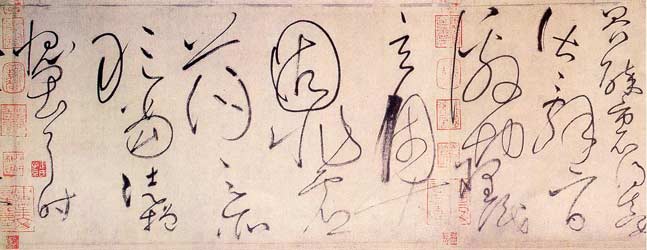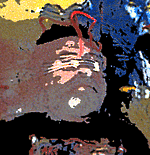Update 01-Feb-2007 NOTE: The story here is as valid today as when it was first written in 2000. The health issue provided a strange and erie dilemma. Still, the modi operandi are alive and functioning well, thank you.

At the end of the first week of Febrary 2000, I began my convelesence from spinal tumor surgery. I escaped my deepest fear of death by the luck-of-the-draw, so to speak. The tumor was benign. Pre treatment conditions found me almost completely paralyzed from the bottom of the rib cage to the tip of my toes. Also affected was my left arm.
What do you do? Go on. Post surgery was equally trying, but on a different level. Fear of death is now replaced with a sense of self renewal covering the basic essentials of life itself. My artwork needed to find a place that related to this self renewal. I could not lift anything for months. Working on canvas was definitely out of the picture. I turned to a renewed interest in work on paper. My process and concept was the barest. I needed to find a way to complete mind-connections quickly and with little physical effort. My powers of concentration as well as physical strength lasted only 2 hours; then my day was over.
After an absence of almost 30 years, I re-introduced myself to Ch'an and Zen Study; thinking, reading, feeling, dreaming. Where do I start? I needed to start over; renew my acquaintence with the tenets of Ch'an (Zen) Budhism and Budhism itself. Shodoka became a beginning point.
CHENG-TAO-KO ----- Shodoka -----Song of Enlightenment. - a collection of 64 verses from the T'ang Dynasty China, attributed to the Zen Master Yung-chia Hsuan-chueh (665-713), and presenting the basic tenets of the Ch'an (Zen) Buddhism.
Below are some Shodoka verses that I find relevant to my current painting.
Source: www.ciolek.com/WWWVLPages/ZenPages/Daily-Zen-Sutras.html
The mind-mirror is clear, so there are no obstacles.
Its brilliance illuminates the universe
To the depths and in every grain of sand.
Multitudinous things of the cosmos
Are all reflected in the mind,
And this full clarity is beyond inner and outer.
One level completely contains all levels;
It is not matter, mind nor activity.
In an instant eighty-thousand teachings are fulfilled;
In a twinkling the evil of eons is destroyed.
All categories are no category;
What relation have these to my insight?
Beyond praise, beyond blame, --
Like space itself it has no bounds.
Right here it is eternally full and serene,
If you search elsewhere, you cannot see it.
You cannot grasp it, you cannot reject it;
In the midst of not gaining,
In that condition you gain it.
By reading these chance selected tenets , you begin to expose the picture. , you begin to expose the picture.
SHA RI SHI SHIKI FU I KU- KU- FU I SHIKI
Shariputra, form is no other than emptiness, emptiness no other than form;
SHIKI SOKU ZE KU- KU- SOKU ZE SHIKI
form is exactly emptiness, emptiness exactly form;
JU SO- GYO- SHIKI YAKU BU NYO ZE
sensation, perception, mental reaction, consciousness are also like this.
SHA RI SHI ZE SHO HO- KU- SO- FU SHO- FU METSU
Sha-riputra, all things are essentially empty-- not born, not destroyed;
FU KU FU JO- FU ZO- FU GEN
not stained, not pure; without loss, without gain.
ZE KO KU- CHU- MU SHIKI MU JU SO- GYO- SHIKI
Therefore in emptiness there is no form, no sensation, perception, mental
reaction, consciousness;
MU GEN-NI BI ZES-SHIN I
no eye, ear, nose, tongue, body, mind,
MU SHIKI SHO- KO- MI SOKU HO-
no color, sound, smell, taste, touch, object of thought;
MU GEN KAI NAI SHI MU I SHIKI KAI
no seeing and so on to no thinking;
MU MU MYO- YAKU MU MU MYO- JIN
no ignorance and also no ending of ignorance,
..
The end
.. as well as the beginning  
What is Zen? (the simple question)
Zen is short for Zen Buddhism. It is sometimes called a religion and
sometimes called a philosophy. Choose whichever term you prefer; it simply
doesn't matter.
Historically, Zen Buddhism originates in the teachings of Siddhartha
Gautama. Around 500 B.C. he was a prince in what is now India. At the age
of 29, deeply troubled by the suffering he saw around him, he renounced his
privileged life to seek understanding. After 6 years of struggling as an
ascetic he finally achieved Enlightenment at age 35. After this he was
known as the Buddha (meaning roughly "one who is awake"). In a nutshell, he
realized that everything is subject to change and that suffering and
discontentment are the result of attachment to circumstances and things
which, by their nature, are impermanent. By ridding oneself of these
attachments, including attachment to the false notion of self or "I", one
can be free of suffering.
The teachings of the Buddha have, to this day, been passed down from
teacher to student. Around 475 A.D. one of these teachers, Bodhidharma,
traveled from India to China and introduced the teachings of the Buddha
there. In China Buddhism mingled with Taoism. The result of this mingling
was the Ch'an School of Buddhism. Around 1200 A.D. Ch'an Buddhism spread
from China to Japan where it is called (at least in translation) Zen
Buddhism.
What is Zen? (the real question)
This question basically asks "What is the essence of Zen?". It appears in
various guises throughout Zen literature, from "What is the meaning of
Bodhidharma's coming from the West?" to "Have you eaten yet?". The question
cuts right to the heart of the matter and can only be answered by you.
Perhaps the best answer is "practice".
Why do people post such nonsense to this group?
One of the central points of Zen is intuitive understanding. As a result,
words and sentences have no fixed meaning, and logic is often irrelevant.
Words have meaning only in relation to who is using them, who they are
talking to, and what situation they are used in. Some postings are indeed
nonsense; other postings appear to be nonsense at first but this is because
the meaning is all between the lines. Zen and poetry have gone hand in hand
for centuries.
Source: Frequently Asked Questions from alt.zen
www.ibiblio.org/zen/faq.html

To push the issue into the light..... goto Huai-su Ink Scroll,  Large File - please allow time to load! Large File - please allow time to load!

Tang Dynasty Ink Scroll. Huai-su, 618 - 907 AD, 12-1/4"h x 594-1/2"w. (section detail)

Source:
www.ChineseArtWorld.com/Nigensha/c4.htm Link has expired.



|







